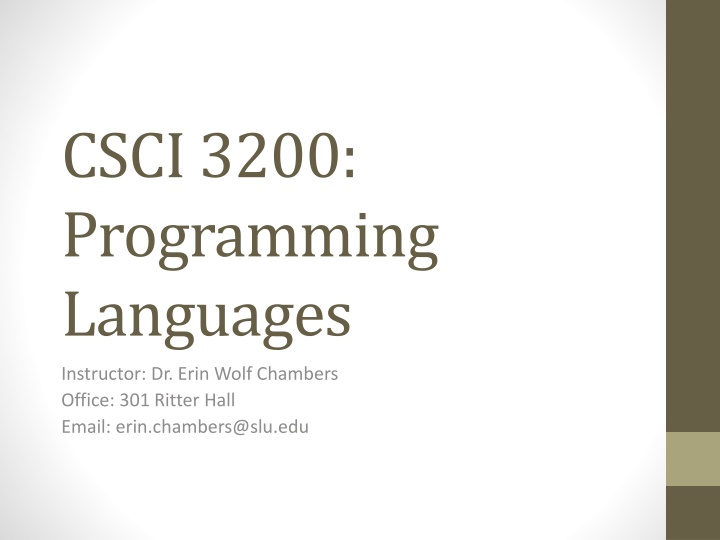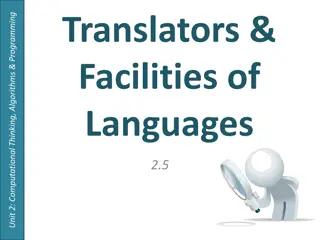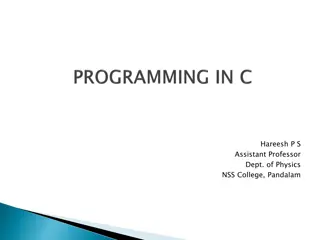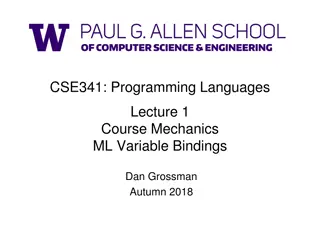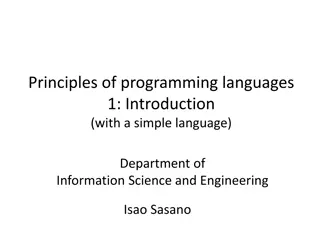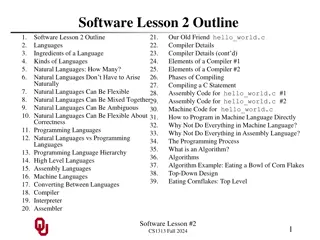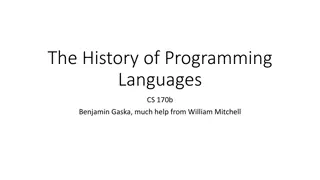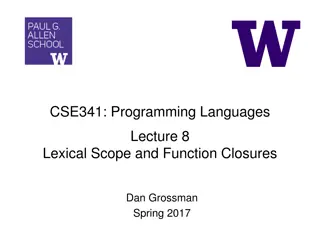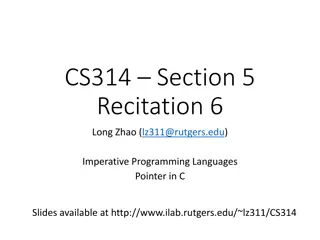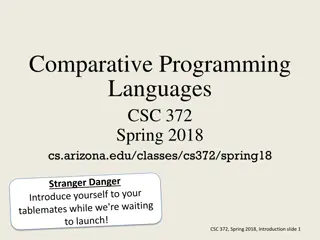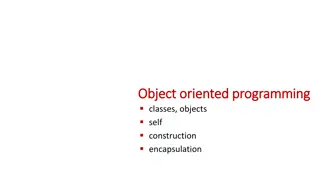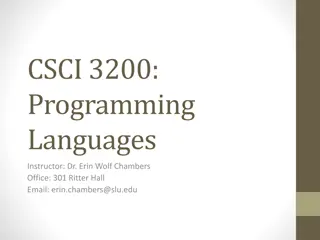Programming Languages
This content delves into programming languages, their evolution, categorization, high vs. low level distinctions, why numerous languages exist, and computing paradigms. It covers historical context, importance of common languages, and the impact of various programming paradigms like declarative and imperative. Special purpose languages, ease of use, learning curves, and other issues in programming languages are discussed. The overview includes key concepts, historical developments, and the relevance of different languages in modern computing.
Download Presentation

Please find below an Image/Link to download the presentation.
The content on the website is provided AS IS for your information and personal use only. It may not be sold, licensed, or shared on other websites without obtaining consent from the author.If you encounter any issues during the download, it is possible that the publisher has removed the file from their server.
You are allowed to download the files provided on this website for personal or commercial use, subject to the condition that they are used lawfully. All files are the property of their respective owners.
The content on the website is provided AS IS for your information and personal use only. It may not be sold, licensed, or shared on other websites without obtaining consent from the author.
E N D
Presentation Transcript
CSCI 3200: Programming Languages Instructor: Dr. Erin Wolf Chambers Office: 301 Ritter Hall Email: erin.chambers@slu.edu
Today: Syllabus overview (boring but necessary) HW 1 is posted due next Wednesday An intro to programming languages
First Question: What programming languages have you used before? Python C++/C Java? Matlab? Others?
Categories of langauges There are many ways to categorize programming languages. Main starting point: High level versus low level Examples? In fact, initially, there only were extremely low level languages: each machine architecture had its own built in language.
High level languages This began to change in the 1950s with Fortran, when people realized it would make more sense to have common languages and then translate them for the machine This is the advent of the notion of compilation. The idea was slow to catch on, since compiled code was usually slower to run.
Why so many? Programming languages are still very much evolving: Structured programming (using loops and function calls) was developed in the late 1960 s. Object orientation was only introduced in the 1980 s. Modern scripting languages (Ruby, Python, etc.) are often less than 20 years old Functional programming is seeing a huge push in recent years
Why so many? (cont) Special purpose languages are very common: C is good for low level coding, like OS development. Prolog is good for logical relationships and AI applications. Awk is good for character and string manipulations. Python and perl are good for scripting.
Other issues: Ease of use Learning curve Standardization Open source Good compliers available Economics and hisotry Pure inertia
Paradigms of computing The major paradigms we ll discuss this semester are: 1. Declarative languages: focus is on what the computer should do. 2. Imperative languages: focus is on how the computer should do something. (This is the dominant paradigm.)
Imperative language categories 1. von Neumann: Fortran, C, etc. - based on computation with variables 2. Scripting languages: bash, awk, perl, etc. - subset of von Neumann, but tailored for ease of expression over speed 3. Object oriented: - traces back to Simula 67, and descended from von Neumann, but focus is on objects rather than pure variables
Declarative language categories 1. Functional languages: Lisp, Scheme, Haskell, etc. based on recursive definitions of functions Inspired by lamba calculus 2. Logic based: prolog computation is based on attempts to find values that satisfy specified relationships 3. Data flow: id, val flow of information (tokens) among nodes
Some examples: Consider the gcd algorithm (finding the greatest common divisor) Euclid s algorithm:
GCD in C int main() { int i = getint(), j = getint(); while (i != j) { if (i > j) i = i - j; else j = j - i; } putint(i); }
GCD in Haskell Haskell is based entirely on function calls there is essentially no such thing as a variable in this language. selfGCD :: Integral f => f -> f -> f selfGCD a b = if b == 0 then a else selfGCD b (mod a b)
GCD in prolog Prolog is all about stating true axioms, and then evaluating for something to be true based off these gcd(X,Y,Z):- X>=Y, X1=X-Y, gcd(X1,Y,Z). gcd(X,Y,Z):- X<Y, X1=Y- X, gcd(X1,X,Z). gcd(0,X,X):- X>0.
A note on outcomes (or: why the heck study this?) Professionally, choosing an appropriate language is a key skill Studying language design will make learning new languages easier This also establishes a common terminology for comparison of languages It is difficult to understand hidden features of various languages we ll look at a lot of them. Need to understand actual implementation cost.
So: diving in A first distinction is compilation versus interpretation Compilation: Interpretation:
Compilation vs. Interpretation In reality, the difference is not so clear cut. These are not opposites, and most languages fall somewhere in between on the spectrum In general, interpretation gives greater flexibility (think python), but compilation gives better performance (think C++)
Compilation vs. Interpretation Most languages do include a mix of these: Note that compilation doesn t have to produce machine code just a translation to another language Think of Java, for example
Implementation of compilation Preprocessing: removes white space and comments groups characters into tokens expands abbreviations identifies higher level syntactic structures i.e. loops and subroutines This is often known as scanning we ll spend the first few weeks talking about it.
Compiling (cont.) Next: routines and linking Compiler uses a linker program add subroutines from a library You ve done this if you ever used a #include from the standard template library
Compilers (cont) Post-compilation assembly output: why?? Makes debugging and optimizing easier, since assembler is MUCH easier than machine code Isolates compiler from low level machine changes many architectures can use the same assembly, but machine level code is very specific
Compilers (cont) In interpreted languages, the compiler still generates code. But assumptions about inputs are not finalized. At runtime, checks assumptions. If valid, runs quickly. If not, a dynamic check reverts to the interpreter.
Next time We ll be spending our first few weeks on compilers, since a basic understanding of this helps to understand programming language design. Remember, compilers is usually a class all by itself! We ll be covering just enough of the basics to get us by. We won t even really get to the lower level stuff from the previous slide go take a compilers course to cover that. Next up: scanning and tokenizing
